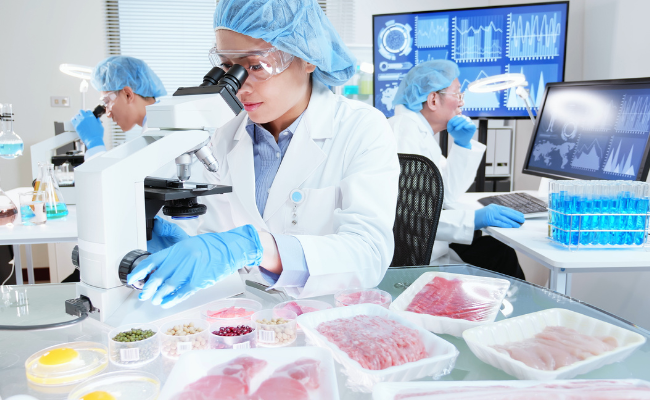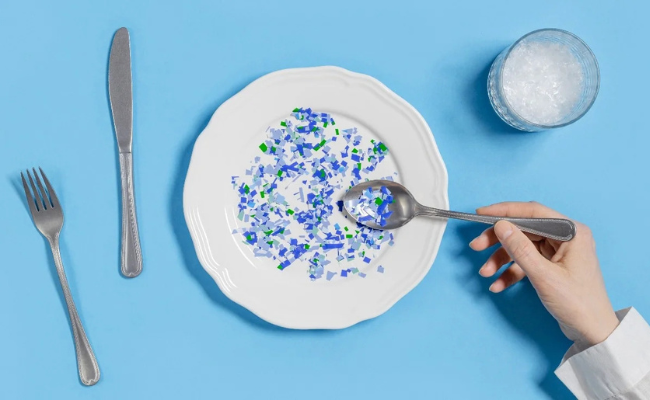Microplastics in Food Supply: The Invisible Threat
Microplastics in food are a growing environmental concern and silent invaders of our diets. These tiny plastic particles come from various sources. In addition, research has shown that they can accumulate in our tissues, possibly causing adverse effects on our health.
In this article, we’ll discuss how microplastics enter our food supply, their potential risks, and how to minimize your exposure.
Understanding Microplastics
 Knowing what microplastics are and how they form is crucial to understanding the impact of microplastics on our food supply and health. Let’s look at microplastics and how they find their way into the food chain:
Knowing what microplastics are and how they form is crucial to understanding the impact of microplastics on our food supply and health. Let’s look at microplastics and how they find their way into the food chain:
Defining Microplastics
Microplastics are minuscule plastic fragments that can vary significantly in size and composition, with the tiniest particles being invisible to the naked eye. They can come from different types of plastic materials.
These include PE, PBS, and PVC and come in various shapes, colors, sizes, and densities. Primary and secondary microplastics are classified based on their origin before entering the environment.
Sources of Microplastics in Food
Microplastic particles can enter the environment through a wide range of sources. A significant way this happens is through the disintegration of larger pieces of plastic.
Other ways include microbeads in personal care products and synthetic fibers from textiles. These particles can then end up in water bodies, soil, and air through run-off, wastewater discharge, and atmospheric deposition.
Microplastics have also been detected in various food sources, including seafood, tap water, and bottled water. One study has found that humans ingest an estimated 70,000 microplastic particles per year through their diet.
Health Risks of Microplastics in Food
Although the ingestion of microplastics might not have an immediate effect on your health, continual consumption might lead to severe health issues.
Potential Health Concerns
Scientists have found that plastic packaging contains at least 15 chemicals that disrupt hormones in the body, known as endocrine disruptors. These chemicals are structurally similar to estrogen, testosterone, and insulin hormones.
These disruptors cause adverse health effects. Specifically, it reduces the availability of estrogen and testosterone, increasing the risk of infertility and polycystic ovary syndrome in both males and females.
A 2020 review uncovered microplastics’ health risks, including inflammation, which can be harmful to gut health and the immune system. The gut has a significant role in the immune system, containing around 70-80% of the body’s immune cells. A weakened stomach can adversely affect immune health.
Continuous exposure to microplastic particles can cause conditions like dysbiosis, a disturbance of the gut microbiota. Dysbiosis further leads to the overgrowth of harmful bacteria and other microorganisms, leading to Parkinson’s disease.
Long-Term Effects of Microplastics in Food
Many studies have been carried out and shown that a high amount of microplastics in the human body increases the chances of developing type 2 diabetes and heart disease.
Experts have linked elevated levels of dioxins, phthalates, and BPs to pre-disease inflammation, insulin resistance, and obesity, increasing the likelihood of diabetes. Some research suggests that microplastic in food harms health to the same extent as an imbalanced diet.
You may also like: New York State to Ban Plastic Bags
Factors Contributing to Microplastic Food Contamination
From the food we eat to the water we drink and bathe with, it is challenging to stay 100% free from microplastics. Here are some factors that encourage plastic pollution:
Environmental Impact of Plastic Pollution
The effects of microplastics are growing rapidly as our consumption and disposal of plastic increases. We discard around 360 million tons of plastic annually, leading to accumulation in oceans, land, and even the food chain due to its slow degradation.
Plastic accumulation damages the marine environment and threatens wildlife over time. The production and disposal of plastic derived from fossil fuels also contribute to climate change and contamination of the soil and oceans.
Food Packaging and Processing
Microplastic contamination can be traced to food packaging and processing which releases small plastic particles during production, transportation, or even storage. A major example of this is plastic bottled water, plastic shopping bags, and frozen food packaging.
Agricultural activities such as plastic mulching, irrigation, and plastic waste disposal also add to the problem. These plastic fragments can infiltrate the soil, water sources, and food chain, affecting human health and the environment.
Food Safety Regulations and International Efforts

Current Regulations and Monitoring
The European Union (EU) has established numerous policies and legislation to combat marine litter, including microplastics, despite the absence of specific regulations on microplastics and nanoplastics as food contaminants. These initiatives target the sources and effects of marine litter, aiming to reduce microplastics’ impact on human health and the environment.
Furthermore, the EU has launched research and innovation programs relevant to the marine environment to comprehend the issue and develop efficient solutions. Although further work is necessary, these initiatives are crucial to minimizing the impact of microplastics and other types of waste.
Global Initiatives to Reduce Contamination
Various global initiatives have been created to reduce the amount of microplastics in food. These include research studies, regulatory measures, and technological innovations geared toward decreasing the exposure and release of microplastic particles in the food chain.
International organizations like the United Nations and the World Health Organization are also taking steps to establish guidelines and standards to tackle the issue. Consumer awareness and demand for plastic-free products contribute to the drive for change in this area.
Reducing Exposure to Microplastics in Food
Apart from regulations and initiatives that have been put in place, a few lifestyle changes could help reduce microplastic consumption drastically.
Practical Tips for Consumers
To limit the release of microplastics and reduce your plastic footprint, here are some suggestions:
- Ensure proper disposal of plastic waste based on recycling rules in your location.
- Minimize the use of nonessential or single-use plastics. These include reusable bottles, coffee cups, shopping bags, and declining plastic cutlery and straws.
- Use filters in washing machines to remove microplastics from wastewater before it enters the treatment system.
- Avoid using products that contain microbeads. These include products like toothpaste, body washes, and cosmetics to further reduce your exposure to and release of microplastics.
You may also like: Goodbye to Acid Reflux: 10 Delicious Foods That Can Help
Supporting Sustainable Agricultural Practices
Promoting sustainable agricultural practices can positively impact food production and reduce the effects of microplastics on human health. This can involve adopting organic farming methods, minimizing the use of pesticides and fertilizers, and implementing water conservation techniques.
Consumers can contribute to sustainable agriculture by purchasing seasonal and locally grown produce, supporting small-scale farmers, and choosing products certified by sustainable farming organizations. Sustainable agriculture is vital for food security and minimizing negative environmental impacts for future generations.
Conclusion
The issue of microplastic contamination in the food supply and ecosystem is of paramount concern. We have examined the sources and impacts of microplastics and the pathways through which they can enter our food.
We have also explored some global and individual initiatives to reduce microplastic contamination. It is now up to each of us to take action by reducing our plastic usage and supporting sustainable agricultural practices.
Together, we can address the issue of microplastics and safeguard human and environmental health for generations to come. Let us all take responsibility and work collectively towards a future free of plastic.


